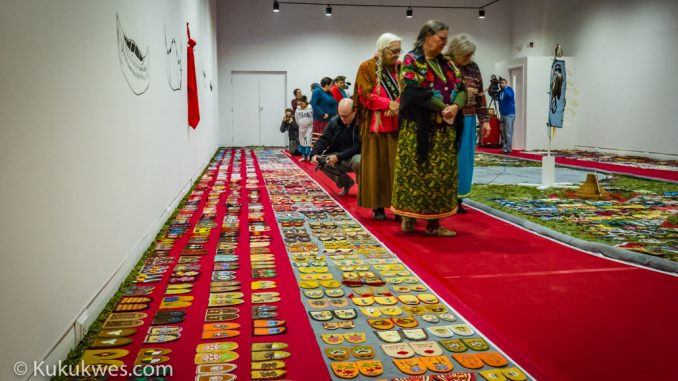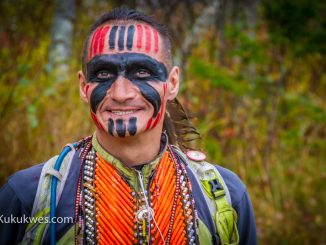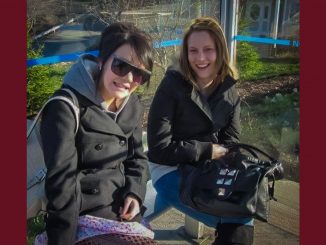
Agnes Gould said she was overwhelmed with emotion when she spoke about her missing sister, Virginia Sue Pictou-Noyes, during a ceremony prior to the opening of an art exhibition to commemorate missing and murdered Indigenous women and girls at Mount Saint Vincent University in Halifax.
“Even though I speak about (her) at other venues and things like that, this time it hit me hard because I’m standing amongst these others that have similar stories of losing loved ones,” she said Saturday following the two-hour closed-door ceremony.
MMIW Series: Virginia Sue Pictou-Noyes
Pictou-Noyes was being treated at a hospital in Bangor, Maine after she was badly beaten when she disappeared on April 24, 1993. The 26-year-old mother of five was last seen walking out of the hospital.

Gould, who travelled from Membertou First Nation, N.S. joined other family members of missing and murdered loved ones inside the Mount Saint Vincent University Art Gallery to lay down their decorated moccasin tops, called vamps, as part of a commemoration exhibition called Walking With Our Sisters.
The exhibition, created by Metis artist Christi Belcourt, includes more than 1,800 pairs of decorated or beaded moccasin vamps donated by family members of the missing and murdered Indigenous women, girls and two-spirited people. It also includes more than 100 vamps representing the children who never came home from residential schools.
The commemoration exhibition has been on display in galleries in Ontario, the western provinces, the Yukon and Northwest Territories since 2013. Mount Saint Vincent University Art Gallery is the only gallery in Atlantic Canada chosen to display this exhibition. The show at MSVU runs until February 1.
The exhibition includes pairs of vamps that are laid down on cloth in a counter-clockwise direction along with cedar boughs. A fabric path is created between the display for visitors to walk and view the vamps.
“The vamps, of course, represent unfinished lives, unfinished moccasins,” Ingrid Jenkner, Director of the Mount Saint Vincent University Art Gallery, said.
“The idea is that the sisters have gone on a journey (and) we will go on it with them,” she added.
Art gallery transformed into ceremonial lodge
The entire exhibition is always in traditional ceremony. Visitors are required to removed their shoes and women are offered a long skirt to wear before entering the art gallery. Inside, a smudging bowl is located at the gallery’s entrance.
Visitors are asked to take a small tobacco pouch to hold while they walk through the exhibit. Before they exit the exhibit, visitors are asked to place the pouch in a box. At the end of each day, the tobacco pouches are burned as an offering.
“This exhibition is completely unlike an art exhibition. It is, in fact, more like a lodge where a ceremony is being held,” Jenkner said.

Gould, who made a pair of vamps for her sister, said it felt good to include them as part of the exhibition.
“I picked an area where she would have loved to have gone,” Gould explained. “Instead of them being perfectly together, she would have been like one toe on top of each other,” she said.
“She would have liked one toe over the other. You know, when you’re fidgety or restless, she was one of those,” Gould said.
Natalie Gloade of Millbrook First Nation, N.S. also took part in the ceremony to contribute a pair of beaded vamps made by a friend in memory of her own mother, Nora Bernard.
Bernard, a survivor of the Shubenacadie Indian Residential School, led one of the largest class action lawsuits in Canada against the federal government and the Roman Catholic church over the abuse Indigenous students suffered while they attended residential schools.
The 72-year-old woman was killed on December 26, 2007 in her home by her grandson and Gloade’s son, James, who pled guilty to manslaughter in January 2009.
During the closed-door ceremony, Gloade said she kept visualizing her mother at the ceremony with her.
“If it was her mother or a relative of hers, I know Mom would have been there and speaking from the heart,” Gloade said following the ceremony.
“I know she would have been one of the strongest voices that would have spoke up on behalf of the missing and murdered Aboriginal women,” she said.
“It was a great honour to be able to hear her voice and to be able to speak her name and to be able to just give a little blurb of who she was and how important she was to all of us,” Gloade said.
The next stop for this art exhibition will be at the Sheguiandak First Nation in Ontario from July 14 to August 7.




